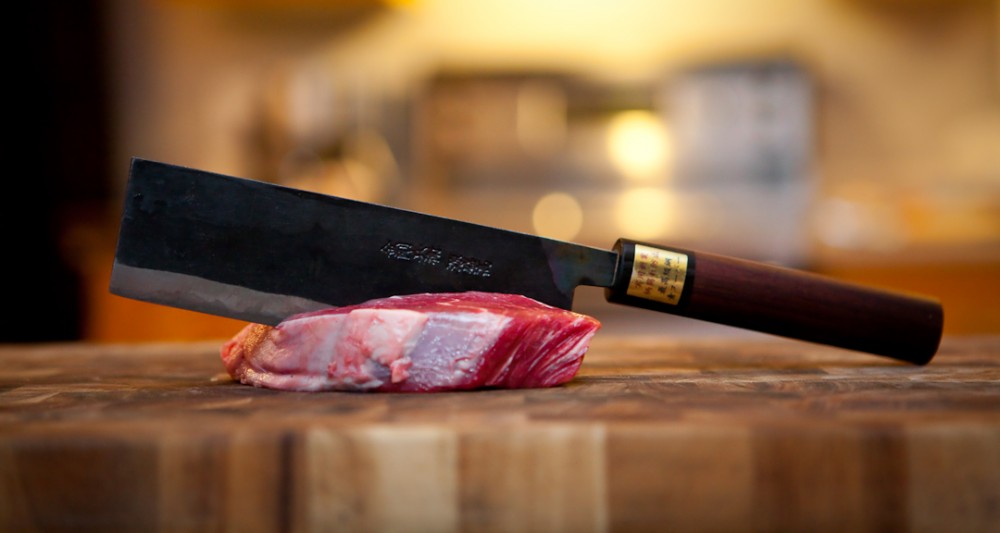I like reading reviews of kitchen knives, but somewhat paradoxically I find most of them to be of little value. The problem is that when it comes down to it, a kitchen knife is a rather simple object; a piece of steel with a handle. The best topics for reviews are things like food, movies, and books, which are often complex and, more importantly, subjective. Two highly respected film critics, such as Siskel and Ebert, can have wildly different opinions on the quality of a particular movie. The same goes for books and restaurants. A knive’s shape, weight, and the type of steel can all be objectively measured, so there cannot be a great deal of serious debate on the fundamental quality of a knife. So with that disclaimer out of the way, I will now write a knife review. Take from it what you will.
For my first ever knife review, I will of course start with the knife that is pictured on the first page of this website, the Moritaka Hamono Aogami super steel nakiri. Aogami super steel is a high carbon steel that is extremely hard, which means it can take and hold an extremely acute cutting edge. On the downside, because it is so hard, it is also delicate, and can easily chip or even be cracked off if the user is too rough with it. And because it is carbon steel, it will rust if left wet for any amount of time.
Before choosing to buy a knife like this, you first need to decide if you really want a carbon steel knife. Most people would probably prefer a rugged but high quality European style chef knife that you can hack meat off a bone with and then throw in the dishwasher. A carbon steel Japanese knife is best suited to those who want an extremely sharp knife for making precision cuts on vegetables or boneless meats and who are willing to hand wash and immediately dry it every time they use it.
If you decide that you want a Japanese carbon steel knife you have many types of carbon steel to choose from; White (Shirogami) 1 or 2, Blue (Aogami) 1 or 2, or Blue (Aogami) super steel. Of these steels, the Aogami super steel is the hardest and also tends to be the most expensive. If you are going to spend the money on this type of knife, you might as well spend a little more and go with the super steel. Moritaka has options in both Blue #2 and the super steel.
If you decide you want an Aogami super steel knife, you then need to decide what knife maker you want to go with. For Aogami super steel knives, Takeda is widely considered the leader, and is priced accordingly. Moritaka knives, though very expensive in their own right, are still significantly cheaper than Takeda. If Takeda knives are in fact better, and that is very much up to debate, the differences would likely be imperceptible to the average home chef.
Aside from being inexpensive as far as very expensive knives go, Moritaka Hamono is both one of the most interesting and admirable companies you will ever find. Moritaka started out producing samurai swords over 700 years ago before applying their blade making skills to knives once people starting using knives to cut meat and vegetables instead of other people. It is also the most refreshingly earnest company you will ever come across.
Though its knives are as long lasting as anything on the market, the Moritaka website actually has a page that shows how its knives will wear over time under heavy use. For the average home cook, the knives will last several lifetimes, but the people at Moritaka want to make clear that if you use this knife every day in a restaurant and sharpen it frequently, it will wear down over time. The website shows what the knife could like after 8 and 15 years of heavy use and regular sharpening. The knife that they show on the website is one used at the “local lunch centre”.
Speaking from personal experience, I bought my Moritaka nakiri knife almost a year ago and use it almost every day. Though I hone it every time I use it, I have not given it a proper re-sharpening with the stones and it can still shred receipt paper. Except making a few sample cuts on receipt paper in a knife store, the Moritaka is the only carbon steel knife I have really used, so I can hardly say that it is any better or worse than its competitors. I can only say that from personal experience I feel like I have gotten great value for the money I paid for the knife.

